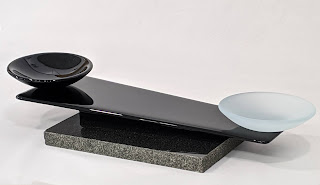Bullseye Reactive Glass
 |
| Table full of reactive samples |
Glass is typically colored with minerals. Some minerals, when they come in contact with other minerals, "react". This reaction often shows up as a fine-colored border where the glasses touch. This border is often brown, black, or reddish brown. There can also be a shift in overall color because of the reactions.
Copper, lead, and sulfur are the typical minerals that may cause a reaction. In addition, silver may cause a reaction and there are also clear glasses that are manufactured to be reactive. Devon provided a chart that explained the combinations that have the potential to react:
- Copper + sulfur
- Copper + reactive glass
- Lead + sulfur
- Copper + silver leaf
- Reactive + silver leaf
- Reactive + copper leaf
It was an interesting exercise that really got me thinking about potential reactions, and in some instances, how to control a reaction by using clear glass or clear frit. Below are a few of the pieces we analyzed (I apologize for the quality of the photos -- they were taken with an Android tablet!).
 |
| Sulfur-bearing reds react with silver |
Some of the more interesting reactions involved silver leaf. In the piece to the right, both of the red glasses used contain sulfur. The sulfur reacts with the silver leaf. In this instance, the leaf was capped with clear -- notice how the reaction travels along the edges of the cut glass.
 |
| Silver reaction |
The piece to the left is featured in a Bullseye tutorial, A Riot of Effects. In this piece, the silver leaf was not capped. Notice how the reaction from the silver produces a more haloed effect because of this.
 |
| River rock reaction |
This piece uses a technique in another of Bullseye's tutorials, River Rock Reaction. In this sample, the sulfur-bearing French Vanilla and the sulfur-bearing amber react with a lead-bearing cranberry pink powder.
 |
| Reactive cloud opal and silver foil |
The sample below is an interesting piece. Copper-bearing Jade Green Powder was layered over a sulfur-bearing Sunflower yellow. A layer of clear glass powder was used in varying thicknesses to keep areas of the yellow and green from touching, and thus, avoiding the reaction. Where the two glasses do come in contact, you have a bronze-colored reaction. This technique produced an interesting gradient effect.
 |
| Copper-bearing jade reacts with sulfur-bearing yellow |
The piece to the right also uses uncapped silver leaf. Both the orange and the yellow glasses (sorry for the bad color in the photo) contain sulfur, and both react with the silver leaf. (Obviously, I need to get some silver leaf, since I was so intrigued by these reactions!)
 |
| Copper leaf with reactive clear |
And finally, with this sample, copper leaf was placed on top of non-reactive powder blue glass. There is no reaction with these two elements, but the piece was capped with reactive clear, producing the dark color of the copper (normally, copper leaf will change color, but it changes anywhere from a bluish tint to a reddish tint).
 |
| Devon Willis, explaining the reactions seen in the samples |
It was an interesting afternoon and I'm sure I speak for the entire Guild when I say we really appreciate Devon's willingness to spend some time presenting this great information. While I use Spectrum's System 96 glass, this information is still valuable as the theory behind the reactions holds true regardless of the glass being used.
If you would like to learn more, check out Bullseye's web site, including:
and for video subscribers:
(the video lessons are great -- well worth the annual subscription)
And, for you System 96 fusers, you can find information on their reactive glasses on their web site (click here).
I hope you've found this information useful. Now go out and fire up a few reactions of your own!
Dana
Learn more about Bullseye Glass Educational Videos!



